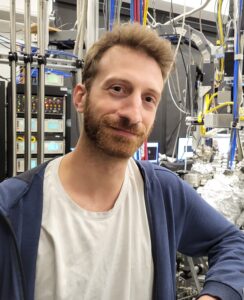
Pictured/credit: Matteo Michiardi.
Most electronic devices exploit the electric charge of the electrons in a material to store and manipulate information. However, electrons possess another fundamental property, their spin, which researchers have long tried to exploit for its potential as a less volatile source of energy. New research from Andrea Damascelli and colleagues at the Stewart Blusson Matter Institute (Blusson QMI) has uncovered a way to use light to control the spin of electrons in semiconductor materials.
The advancement of spin-electronics, or spintronics, has the potential to yield more efficient and faster computing compared to conventional electronics. Published today in the journal Nature Communications, this discovery is an important milestone on the road to faster and more energy-efficient quantum devices.
“Using angle-resolved photoemission spectroscopy (ARPES) and time-resolved ARPES performed at Blusson QMI’s UBC-Moore Center for Ultrafast Quantum Matter, we found a new way to control the spin of the electrons moving through the material using lasers to create optical excitation,” said Matteo Michiardi, a Senior Scientist at Blusson QMI who works closely with Damascelli. “Interestingly, this effect is universal within all semiconductors.”
To control the spin, researchers have typically relied on magnetic or electric fields in materials where the spin is entangled in the direction of the electrical current; this phenomenon is known as spin-orbit coupling. However, optical fields offer an unprecedented platform to control the spin of the electrons, bridging the gap between spintronics and optoelectronics.

Pictured: Andrea Damascelli. Image credit: Paul Joseph/UBC.
“We discovered that by exploiting a physical effect similar to the one that powers photovoltaic (solar) cells, we can change this entanglement, allowing us to control the spin of the electrons flowing in the material,” said Michiardi.
The researchers applied a thin layer of alkali atoms to a bismuth selenide crystal (Bi2Se3) to generate a puddle of free electrons at the surface of the material where the spin-orbit coupling is strong. Using an ultrafast laser pulse, lasting only 200 femtoseconds (quadrillionths of a second), they were able to change the strength of the coupling and the spin direction of the flowing electrons.
“This is particularly exciting because the ability to control spin-orbit coupling with light gives us the opportunity to explore new avenues both in terms of research and device development,” said Michiardi, who designed the experiment and the mathematical models to demonstrate the functionality and clarify the team’s findings.
“The idea is that if you can find a way to use spin rather than charge in an efficient way, you can potentially create hardware for a range of applications that require far less energy to function,” said Damascelli, Professor in UBC’s Department of Physics and Astronomy and Scientific Director, Blusson QMI.
While computing is a potential application for spintronics devices, this research has even greater implications. Spin-orbit coupling is a general effect employed in a number of quantum technology fields, and these findings offer a potentially new way to control quantum properties, a benefit that may be impactful across a range of applications.
Michiardi and colleagues are currently completing the development of a beamline for spin-resolved ARPES at the Quantum Materials Spectroscopy Centre at the Canadian Light Source. The beamline will enable the team to continue this line of research and to develop and test new and interesting systems for novel spintronic functionalities.


